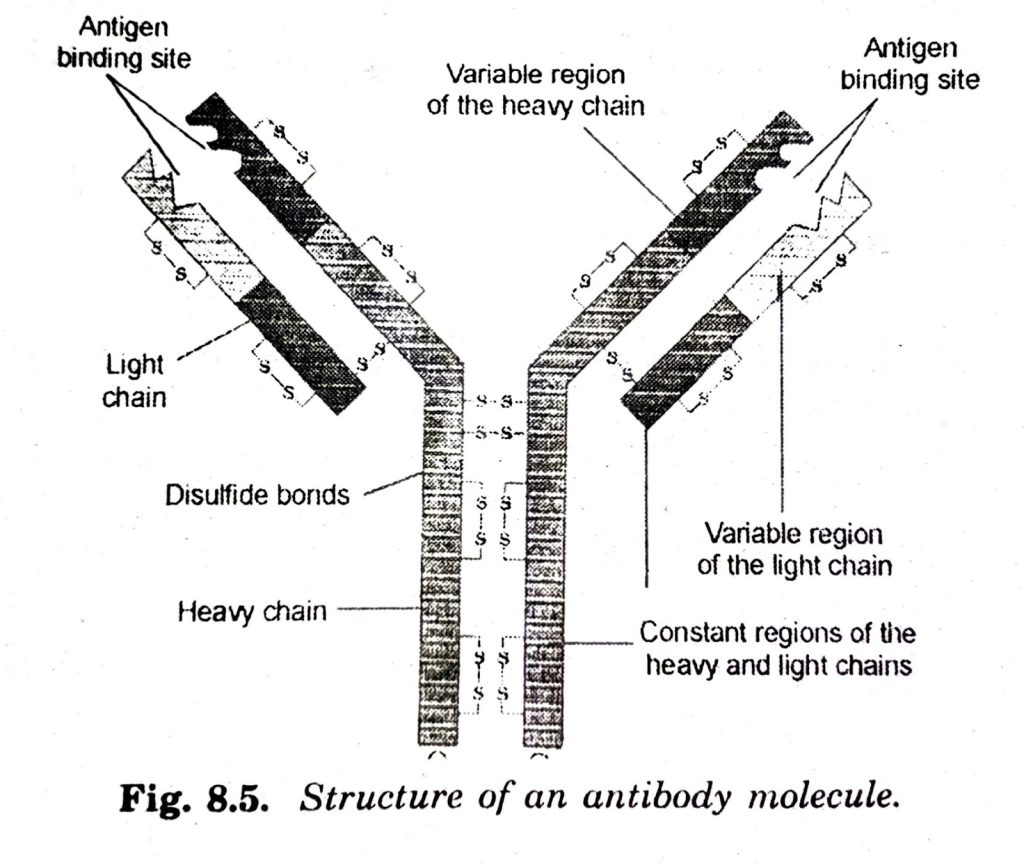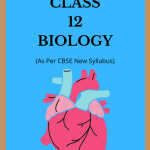NCERT Class 12 Biology Chapter 8 Human Health and Disease Solutions to each chapter is provided in the list so that you can easily browse through different chapters NCERT Class 12 Biology Chapter 8 Human Health and Disease and select need one. NCERT Class 12 Biology Chapter 8 Human Health and Disease Question Answers Download PDF. NCERT Biology Class 12 Solutions.
NCERT Class 12 Biology Chapter 8 Human Health and Disease
Also, you can read the NCERT book online in these sections Solutions by Expert Teachers as per Central Board of Secondary Education (CBSE) Book guidelines. CBSE Class 12 Biology Solutions are part of All Subject Solutions. Here we have given NCERT Class 12 Biology Chapter 8 Human Health and Disease Notes, NCERT Class 12 Biology Textbook Solutions for All Chapters, You can practice these here.
Human Health and Disease
Chapter: 8
BIOLOGY
UNIT – III BIOLOGY AND HUMAN WELFARE
TEXT BOOK QUESTIONS ANSWERS
Q. 1. What are the various public health measures, which you would suggest as safeguard against infectious diseases?
Ans: Public health measures are preventive measures taken to control the spread of infectious diseases. Various public health measures are:
(i) Maintenance of personal and public hygiene.
(ii) Isolation of infected person to reduce the spread of infectious diseases.
(iii) Vaccination.
(iv) Vector Eradication: is done by providing clean environment and prevention of breeding of mosquitoes. This can be achieved by not allowing water stagnation, regular cleaning of coolers, use of mosquito nets and insecticides.
Q. 2. In which way has the study of biology helped us to control infectious diseases?
Ans: Vaccination programmes have helped eradication of diseases. Biotechnology has helped in the preparation of newer and safer drugs and vaccines. Manufacturing of antibiotics have helped in treating infectious diseases.
Q. 3. How does the transmission of each of the following diseases take place?
(a) Amoebiasis.
Ans: Amoebiasis caused by Entamoeba histolytica. It is a vector-borne disease that spreads by the means of contaminated food and water. The vector is housefly.
(b) Malari.
Ans: Malaria caused by Plasmodium. It spreads by bite of infected female Anopheles mosquito.
(c) Ascariasis.
Ans: Ascariasis caused by Ascaris lumbricoides.
It spreads via contaminated food and water.
(d) Pneumonia.
Ans: Pneumonia caused by Streptococcus pneumoniae. It spreads by the sputum of an infected person.
Q. 4. What measure would you take to prevent water-borne diseases?
Ans: Water-borne diseases can be prevented by:
(i) Public hygiene proper disposal of sewage and excreta.
(ii) Cleaning and disinfecting water reservoirs.
(iii) Clean drinking water and food.
Q. 5. Discuss with your teacher what does ‘a suitable gene’ means, in the context of DNA vaccines.
Ans: It means a suitable gene which through recombinant DNA technology can be used to produce antigenic polypeptides of pathogen in bacteria or yeast called sub unit vaccine
Q. 6. Name the primary and secondary lymphoid organs.
Ans: Primary lymphoid organs include bone marrow and thymus.
Secondary lymphoid organs are spleen, lymph nodes, tonsils, Peyer’s patches of small intestine, and appendix.
Q. 7. The following are some well- known abbreviations, which have been used in this chapter. Expand each one to its full form:
(a) MALT.
Ans: MALT: Mucosa-Associated Lymphoid Tissue.
(b) CMI.
Ans: CMI: Cell-Mediated Immunity.
(c) AIDS.
Ans: AIDS: Acquired Immuno Deficiency Syndrome.
(d) NACO.
Ans: NACO: National AIDS Control Organization.
(e) HIV.
Ans: HIV: Human Immuno Deficiency virus.
Q. 8. Differentiate the following and give examples of each:
(a) Innate and acquired immunity.
Ans: Innate and acquired immunity:
(i) Innate immunity: Innate immunity is non-specific type immunity present at the time of birth.
(ii) Innate immunity consist of four types of barriers: Physical barriers, Physiological barriers, Cellular barriers, Interferons.
(iii) Acquired Immunity: Acquired immunity is immunity acquired after birth. It is pathogen specific. It operates by producing primary and secondary responses mediated by B- lymphocytes and T lymphocytes.
(b) Active and passive immunity.
Ans: Active and passive immunity:
(a) Active Immunity:
(i) Host produces antibodies on exposure to infection or vaccination.
(ii) Active immunity is slow and takes time in formation of antibodies.
(b) Passive Immunity:
(i) It is giving the ready-made antibodies directly to protect the body against foreign antigens.
(ii) It gives immediate relief.
Q. 9. Draw a well-labeled diagram of an antibody molecule.
Ans:

Q. 10. What are the various routes by which transmission of human immuno deficiency virus takes place?
Ans: Transmission of HIV-infection occurs via blood and semen by
(i) Sexual contact with infected person.
(ii) Transfusion of contaminated blood and blood products.
(iii) Sharing infected needles by intravenous drug abusers. and
(iv) Infected mother to her child through placenta.
Q. 11. What is the mechanism by which the AIDS virus causes deficiency of immune system of the infected person?
Ans: Mode of action of HIV:
(i) HIV enters human macrophages where virus RNA replicates to form viral DNA with the help of enzyme reverse transcriptase.
(ii) This viral DNA gets incorporated into host cell’s DNA and directs the infected cells to produce virus particles.
(iii) The macrophages continue to produce virus and become HIV factory.
(iv) Simultaneously, HIV enters into helper T-lymphocytes replicates and produce progeny viruses.
(v) The progeny viruses attack other helper T-lymphocytes and causes progressive decrease in the number of helper T lymphocytes in the body of the infected person.
Q. 12. How is a cancerous cell different from a normal cell?
Ans: Cancer cells do not show contact inhibition.
Normal cells show contact inhibition i.e. contact with other cells inhibit their uncontrolled growth.
Q. 13. Explain what is meant by metastasis.
Ans: Malignant tumors:
(i) Metastasis: It spreads to other organs of body through blood and lymph to form secondary tumor.
(ii) It has very rapid growth.
(iii) It invades and damages the surrounding normal tissues.
Q. 14. List the harmful effects caused by alcohol/drug abuse.
Ans: Harmful effects of drug/alcohol abuse are:
(i) Immediate adverse effects of drugs and alcohol abuse are reckless behaviour, aggression and violence.
(ii) Fatigue, Loss of sleep, appetite and weight.
(iii) Loss of interest in hobbies, depression and psychosis. Coma and death due to respiratory failure, heart failure or cerebral hemorrhage.
(iv) Social Problems: absence from school or work, poor hygiene deteriorating relationships with family and friends
(v) Mental and financial distress to family and friends.
(vi) Those who take drugs intravenously are much prone to AIDS and Hepatitis B.
(vii) Chronic use of drugs and alcohol damages nervous system and liver (cirrhosis).
(viii) The use of drugs and alcohol during pregnancy leads to fetal malformation.
Q. 15. Do you think that friends can influence one to take alcohol/drugs? If yes, how may one protect himself/herself from such an influence?
Ans: Yes, friends can influence one to take drugs and alcohol.
Measures to protecting himself/herself against drug abuse are:
(i) Education and Counselling about the harmful effects from drugs.
(ii) Avoid peer pressure and drug abused friends.
(iii) Seek help from parents and peers.
(iv) Extra-curricular activities like sports, yoga etc.
(v) Medical help from psychologists and psychiatrists.
Q. 16. Why is that once a person starts taking alcohol or drugs, it is difficult to get rid of this habit? Discuss it with your teacher.
Ans: It causes Drug Addiction and Dependence.
(i) Drug Dependence is body manifestation of characteristic and unpleasant withdrawal syndrome on abrupt stoppage of regular intake of dose of drugs.
(ii) This is characterised by nausea, sweating, anxiety, tremors, muscle cramps which may be relieved on intake of drugs.
(iii) Withdrawal symptoms can be severe and life threatening.
Q. 17. In your view what motivates youngsters to take to alcohol or drugs and how can this be avoided?
Ans: Common causes of alcohol/drug abuse are curiosity, adventure and excitement, experimentation, stress, depression, family history and peer pressure. Preventive measures against addiction of alcohol and drugs:
(i) Education and Counselling about the harmful effects from alcohol and drugs.
(ii) Avoid peer pressure and drug abused friends.
(iii) Seek help from parents and peers.
(iv) Extra-curricular activities like sports, yoga etc.
(v) Medical help and counseling from psychologists and psychiatrists.

Hi! my Name is Parimal Roy. I have completed my Bachelor’s degree in Philosophy (B.A.) from Silapathar General College. Currently, I am working as an HR Manager at Dev Library. It is a website that provides study materials for students from Class 3 to 12, including SCERT and NCERT notes. It also offers resources for BA, B.Com, B.Sc, and Computer Science, along with postgraduate notes. Besides study materials, the website has novels, eBooks, health and finance articles, biographies, quotes, and more.




